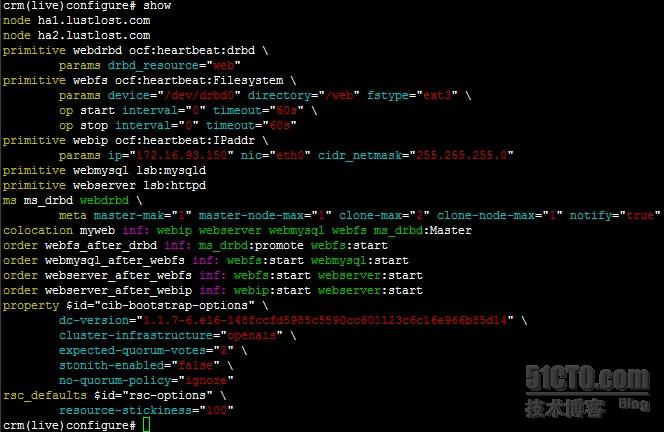在对于业务不能中断而访问量不是很高的网站来说,用2台服务器配置成一主一备的高可用的解决方案是比较常用的手段 本文基于corosync+pacemaker+drbd,来构建一套完整的双LAMP高可用集群系统 |
创建基础环境
首先检查内核是否支持DRBD,我的系统是centos6.2,6.2版本的内核默认是2.6.32-220.el6.i686,DRBD8.3版本需要至少2.6.33内核支持。所以需要安装内核补丁。(我这里centos6.2的内核安装内核补丁出了点问题,在centos5.x系列上没问题,所以实际上我是编译安装的)
DRBD各版本内核支持列表
sohu和163源没有这个8.2的版本在centos官方源下载
http://mirror.centos.org/centos/5/extras/i386/
配置双方hostname,并在hosts文件写入,并建立双方ssh无密码通信
具体步骤这里不再列出
hosts文件
Step1:DRBD
创建要同步的磁盘分区
查看磁盘分区情况
[root@ha1 drbd.d]# fdisk /dev/sdb -l
DRBD安装包分为内核部分和用户空间管理的部分。这2个包都需要安装
[root@ha1 drbd]# yum localinstall kmod-drbd83-8.3.8-1.el5.centos.i686.rpm drbd83-8.3.8-1.el5.centos.i386.rpm
(本人实际是以编译的方式安装,我的配置文件是在/usr/local/etc下面,下面配置文件的路径以rpm包安装为例。centos6.2系统不知为何安装内核补丁有点问题)
在样例配置文件基础上进行配置
[root@ha1 drbd]# cp /usr/share/doc/drbd83-8.3.8/drbd.conf /etc/
编辑全局配置
[root@ha1 drbd]# cd /etc/drbd.d/
[root@ha1 drbd.d]# vi global_common.conf
global {
usage-count no;
}
common {
protocol C;
handlers {
pri-on-incon-degr "/usr/lib/drbd/notify-pri-on-incon-degr.sh; /usr/lib/drbd/notify-emergency-reboot.sh; echo b > /proc/sysrq-trigger ; reboot -f";
pri-lost-after-sb "/usr/lib/drbd/notify-pri-lost-after-sb.sh; /usr/lib/drbd/notify-emergency-reboot.sh; echo b > /proc/sysrq-trigger ; reboot -f";
local-io-error "/usr/lib/drbd/notify-io-error.sh; /usr/lib/drbd/notify-emergency-shutdown.sh; echo o > /proc/sysrq-trigger ; halt -f";
fence-peer "/usr/lib/drbd/crm-fence-peer.sh";
split-brain "/usr/lib/drbd/notify-split-brain.sh root";
out-of-sync "/usr/lib/drbd/notify-out-of-sync.sh root";
before-resync-target "/usr/lib/drbd/snapshot-resync-target-lvm.sh -p 15 -- -c 16k";
after-resync-target /usr/lib/drbd/unsnapshot-resync-target-lvm.sh;
}
startup {
wfc-timeout 120;
degr-wfc-timeout 120;
}
disk {
on-io-error detach;
fencing resource-only;
}
net {
cram-hmac-alg "sha1";
shared-secret "lustlost";
}
syncer {
rate 100M;
}
}
定义资源配置
[root@ha1 drbd.d]# vi web.res
resource web {
on ha1.lustlost.com {
device /dev/drbd0;
disk /dev/sdb1;
address 172.16.93.148:7789;
meta-disk internal;
}
on ha2.lustlost.com {
device /dev/drbd0;
disk /dev/sdb1;
address 172.16.93.149:7789;
meta-disk internal;
}
}
将配置文件cp一份到ha2
[root@ha1 drbd.d]# scp /etc/drbd.conf ha2:/etc
[root@ha1 drbd.d]# scp /etc/drbd.d/* ha2:/etc/drbd.d/
初始化磁盘
在ha1和ha2上执行
drbdadm create-md web
在两个节点都启动服务
[root@ha2 drbd.d]# service drbd status
启动以后设置其中一个节点为主节点,执行下面命令,然后数据会自动同步
[root@ha1 drbd.d]# drbdadm -- --overwrite-data-of-peer primary web
查看同步情况
[root@ha1 drbd.d]# drbd-overview
同步完成之后,在主节点上查看状态
查看备节点的状态
格式化drbd设备
[root@ha1 drbd.d]# mkfs.ext3 /dev/drbd0
挂载至目录
[root@ha1 drbd.d]# mount /dev/drbd0 /web/
Step2:LAMP平台
方便起见就直接yum安装了
[root@ha1 ~]# yum install httpd mysql mysql-server php php-mysql –y
编辑apache的配置,目录指向drbd挂载点的目录
[root@ha1 ~]# vi /etc/httpd/conf/httpd.conf
![]()
编辑mysql的配置,数据目录同样指向drbd挂载点
[root@ha1 ~]# vi /etc/my.cnf
Drbd,Mysql和httpd将配制成集群服务,配置mysql和php开机不启动,由集群服务控制开启和关闭
[root@ha1 data]# chkconfig mysqld off
[root@ha1 data]# chkconfig httpd off
[root@ha1 data]# chkconfig drbd off
然后将ha2节点也配置成一样
Step3:Corosync+pacemaker
安装corosync和pacemaker
[root@ha1 ~]# yum install corosync pacemaker –y
编辑corosync全局配置
[root@ha1 ~]# cd /etc/corosync/
[root@ha1 corosync]# vi corosync.conf
配置如下
# Please read the corosync.conf.5 manual page
compatibility: whitetank
totem {
version: 2
secauth: off
threads: 0
interface {
ringnumber: 0
bindnetaddr: 172.16.93.148
mcastaddr: 226.94.1.1
mcastport: 5405
ttl: 1
}
}
logging {
fileline: off
to_stderr: no
to_logfile: yes
to_syslog: yes
logfile: /var/log/cluster/corosync.log
debug: off
timestamp: on
logger_subsys {
subsys: AMF
debug: off
}
}
amf {
mode: disabled
}
service {
ver:0
name:pacemaker
}
aisexec {
user:root
group:root
}
生成密钥文件
[root@ha2 corosync]# corosync-keygen
可能刚装的系统或者开机比较短的系统,系统墒池没有足够多的随机数,用此命令生成不了密钥文件,可以使用find / 命令让系统进行足够随机的IO一般就可以了
将配置文件拷贝一份到ha2
[root@ha1 corosync]# scp -p corosync.conf authkey ha2:/etc/corosync/
然后进入crm配置界面(话说crm真心好用。命令选项全部都能自动补齐,感觉就像在配置交换路由)
[root@ha1 corosync]# crm
crm(live)# configure
配置三个全局属性
crm(live)configure# property no-quorum-policy=ignore 因为是双节点,所以忽略票数
crm(live)configure# property stonith-enabled=false 关闭stonith设备
crm(live)configure# rsc_defaults resource-stickiness=100 提高资源粘性,防止服务器故障恢复时资源转移
然后规划一下需要配置的资源
在双LAMP节点中,有以下几个资源
IP地址,mysql,httpd,drbd,挂载文件系统。这几个资源都需要在同一个节点上,所以先定义一个组。而且这5个资源启动的先后顺序必须先搞清楚。
首先先定义这几个资源
集群虚拟IP
crm(live)configure#primitive webip ocf:heartbeat:IPaddr params ip=172.16.93.150 broadcast=255.255.255.0
数据库
crm(live)configure# primitive webmysql lsb:mysqld
web服务器
crm(live)configure# primitive webserver lsb:httpd
drbd设备
crm(live)configure# primitive webdrbd ocf:heartbeat:drbd params drbd_resource=web
drbd主从定义
crm(live)configure# ms ms_drbd webdrbd meta master-mak="1" master-node-max="1" clone-max="2" clone-node-max="1" notify="true"mount定义
crm(live)configure#primitive webfs ocf:heartbeat:Filesystem params device=/dev/drbd0 directory=/web fstype=ext3 op start timeout=60s op stop timeout=60s
指定约束,将所有的资源约束在一起
crm(live)configure# colocation myweb inf: webip webserver webmysql webfs ms_drbd:Master
定义次序
crm(live)configure# order webfs_after_drbd inf: ms_drbd:promote webfs:start #将drbd提升为主的才挂载文件系统
crm(live)configure# order webmysql_after_webfs inf: webfs:start webmysql:start #挂载文件系统后才能启动mysql
crm(live)configure# order webserver_after_webip inf: webip:start webserver:start #ip地址配置好以后才启动apache
crm(live)configure# order webserver_after_webfs inf: webfs:start webserver:start
#文件系统挂载完成后才能启动apache
查看一下全部定义好的资源
查看资源启动情况
通过关闭ha1 的网卡,能够成功的把所有资源成功转移到ha2上









